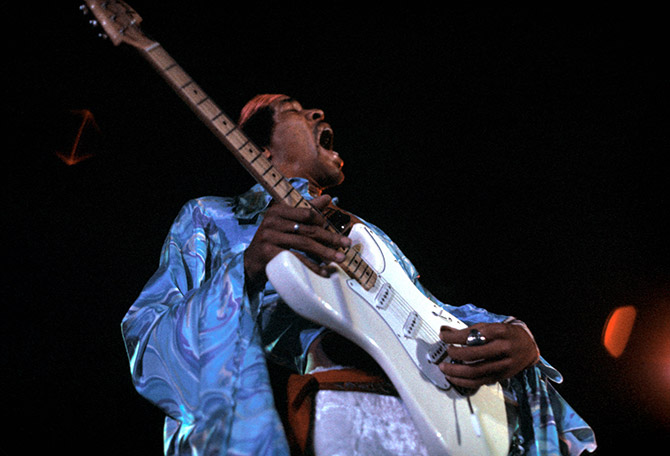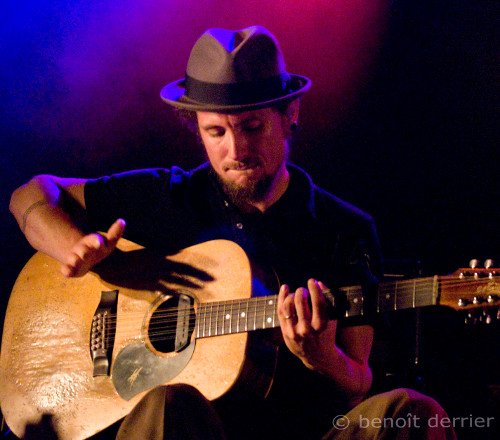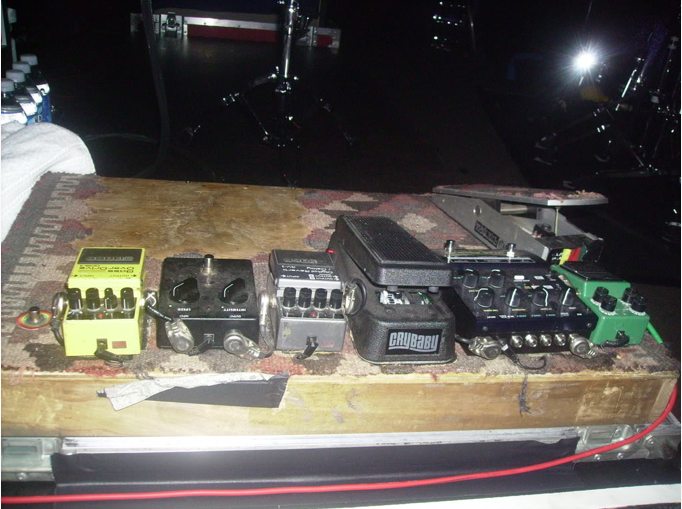Neil Young has just released a new album entitled “Le Noise”. Produced by Daniel Lanois of U2 fame, it is full of old school dirty and gritty fuzz tones enhanced by lush delays and modulation effects (more about the recording here). You can listen to the songs featured in “Le Noise” thanks to this awesome youtube video directed by Adam Vollick:
Category Archives: Guitarists
About guitarists
John Mayer’s Guitar Rig
I don’t have much time to post this week, being busy on a project (more about it soon) so it will have to be a small post.
I found this video on Dunlop’s blog. It shows the touring gear of John Mayer in details and it’s pretty interesting stuff. We can see his Tube Screamer is of the TS10 variety and that he still uses his old Marshall Bluesbreaker pedal (the 90s version):
40 years ago today…
40 years ago today, the man who started it all died a rock star death in London:

The tone of Hendrix is still a mystery today even if everybody is now convinced that his fingers were mainly responsible for it.
Anyway, in order to approach his godly sound a good place to start is Roger Mayer, Hendrix’s own guitar electronics guru. He still makes pedals today, make sure to visit his website. In particular, his series of fuzz is similar in spec to what Hendrix was using in the 60s.
A more mainstream manufacturer, Dunlop, has a series of three pedals in its Hendrix line. Here is a Guitar World video demonstrating them. It comes close enough…
To conclude, here is a link to a funny video of the Jimi Hendrix Experience visiting a street of Paris and positively scaring off the passers-by. This video was apparently buried in some archive vault until now…
So long Jimi!
Guitarists: The Tone of John Butler
It is time for some electric/acoustic action with John Butler. I will attempt to approach his tone using some common and relatively inexpensive pedals.
Australian guitarist John Butler was revealed to the mainstream in 2004 when his third album, “Sunrise Over Sea”, was released. This album included a huge hit single: “Zebra“. John Butler always plays in a trio configuration, hence the name of his band “The John Butler Trio”.

Guitars and Guitar Style
His guitar style and and use of gear are quite original, although not entirely unique. His main instrument is a 12 string acoustic guitar made in Australia by Maton. I should actually say 11 strings since the higher ‘G’ is removed as, according to John Butler, it makes the guitar sound too trebly. This guitar is used “normally” as well as plugged into effect pedals and a Marshall amp to give it a more “electric” vibe.
From a style point of view, John Butler’s mastery of finger picking and slide as well as guitar percussion make him an interesting guitarist to study, quite fresh compared to the heavy rock super fast arpeggios type. Don’t get me wrong, I like super fast heavy metal players but it is sometimes nice to study a different style, which happens to be quite technical too!
John Butler also plays a Dobro, a banjo, a Telecaster or a 6 string acoustic guitar but I will concentrate in this post on his 12 string tone. In this interview, John Butler explains in details what guitar he uses and his signal path, which is fairly complex but I will try to summarise it here.
Signal Path
John Butler’s 12 string Maton is fitted with two pickup systems, one for the “electric” tone and one for the “acoustic” tone.
For the electric tone, the magnetic part of a Seymour Duncan Mag-Mic soundhole pickup is used. This is what goes into the pedal chain. This pedal chain is composed of a Boss ODB-3 Bass Overdrive, a Voodoo Lab Micro Vibe, a Boss RV-2 Digital Reverb, a Dunlop CryBaby 535Q wah and finally an Akai Head Rush E2 delay. The pedal chain then goes into an Avalon U5 instrument DI/preamp. The signal from the Avalon U5 then goes into a volume pedal and an Ibanez TS9DX overdrive before going into a 1975 Marshall JMP Super Lead amp. phew… The volume pedal allows to blend in more or less electric tone, very clever…
Here is a photo of the pedal chain (source here):

For his acoustic tone, John Butler relies on the integrated APMic pickup system devised by Maton for their guitars. The signal from this pickup system goes into an Avalon M5 Microphone Preamp. Both Avalons preamps (the U5 mentioned earlier and the M5) go into a mixer and then into a switcher box and then into the main mixing desk. This is the “acoustic” tone. But from my understanding, since the output of the two avalon preamps are mixed together, some of the pedal effects are part of this acoustic tone, not so purely acoustic then…
John Butler uses the same system live or in the studio. In the latter case, his guitar is also recorded by microphones which gives him another signal to play with. This whole system is very flexible as it can provide a pure acoustic tone, an acoustic tone with effects or a more electric tone. The amount of electric tone can be controlled via a volume pedal.
Let’s Try to Approach John Butler’s Tone
The idea in this series of posts is to try to capture the spirit of one’s tone with a minimum of gear. I hope to inspire you into using an acoustic guitar in an “unconventional” way, that is augmented by an electric guitar amp and effects. I have not tried to reproduce the acoustic/electric duality of John Butler’s setup and have focused on the electrification of an acoustic guitar. It is something than few guitarists do but which can open a world of possibilities.
I am lucky enough to own an Australian made Maton guitar, an EM225C to be precise. It is equipped with the AP4 pickup system, also designed by Maton. It is a fantastic instrument but has “only” 6 strings. So the first pedal I decided to use was a BOSS CH-1 chorus in order to simulate a 12 string tone. I then decided to use a BOSS RV-3 reverb, close enough to the RV-2 John Butler uses. Both the RV-2 and RV-3 are discontinued so you will either have to get the newer RV-5 or look on the second hand market. I also decided to use a BOSS SD-1 overdrive which is a cheap but good enough overdrive. Of course, you could be using an Ibanez Tube Screamer or any other good overdrive, including your amp’s. Finally, I opted for a Morley wah because we all love some wah action.
The final chain went:
Maton EM225C Guitar -> Morley Wah -> BOSS SD-1 Overdrive -> BOSS CH-1 Chorus -> BOSS RV-3 Reverb -> Fender Champ amplifier set clean.
I show at the beginning of the video how a chorus effect can emulate the tone of a 12 string guitar and then I show the whole chain:
The settings were:
- Amp: 1974 Fender Champ with VOLUME at 3, BASS at 10 and Treble at 2.
- BOSS SD-1 Overdrive: Tone 9 o’clock, Level 12 o’clock, Drive 3 o’clock
- BOSS CH-1 Chorus: E.LEVEL 3 o’clock, EQ 2 o’clock, RATE 12 o’clock, DEPTH 2 o’clock
- BOSS RV-3 Reverb: BALANCE 9 o’clock, TONE 9 o’clock, R.TIME 1 o’clock, MODE 9
The amp was miked with a RODE NT-4 and recorded with a BOSS Micro-BR. The recording was then transferred into Cubase 5 to add some compression (mainly to optimise the volume).
